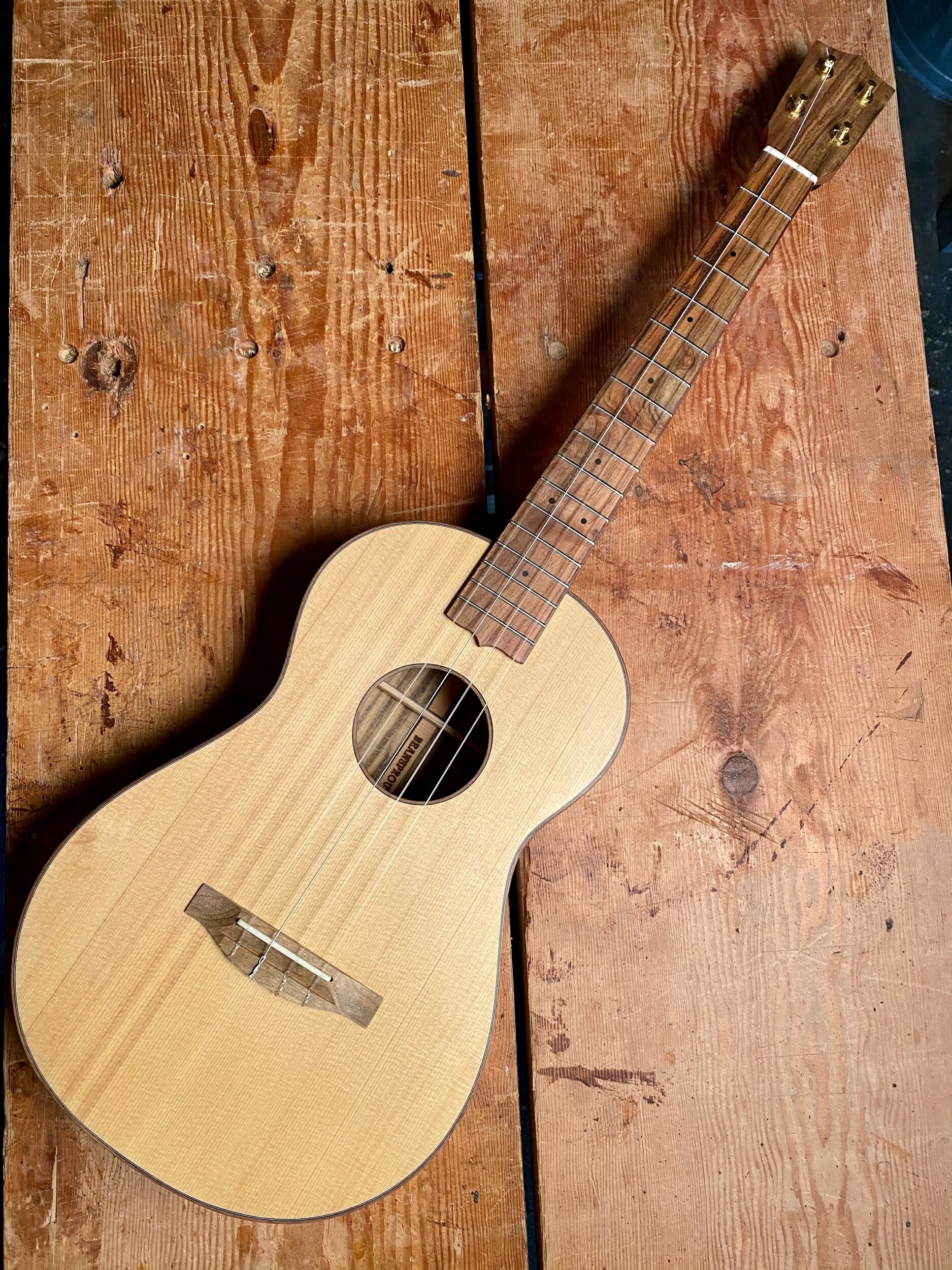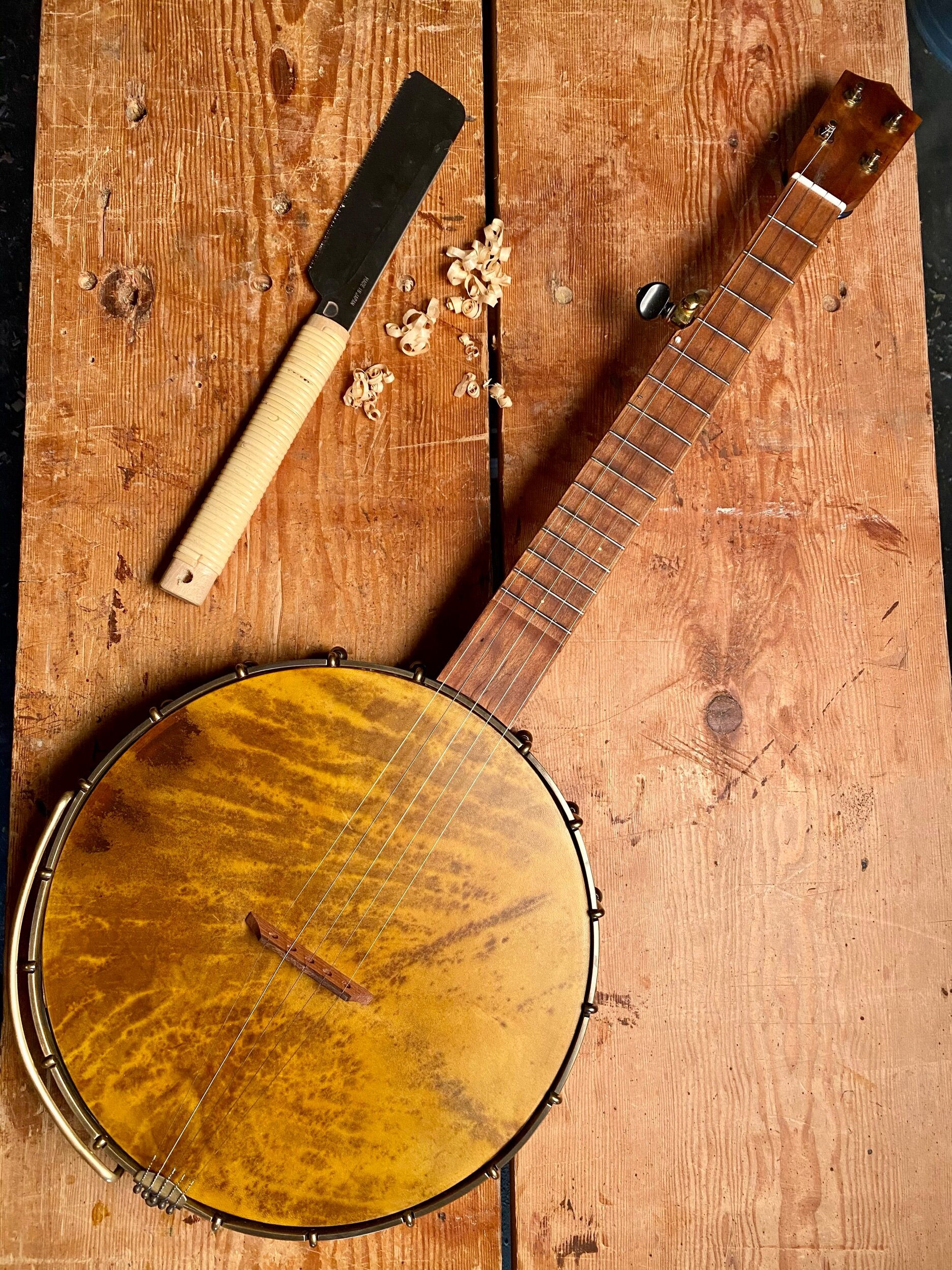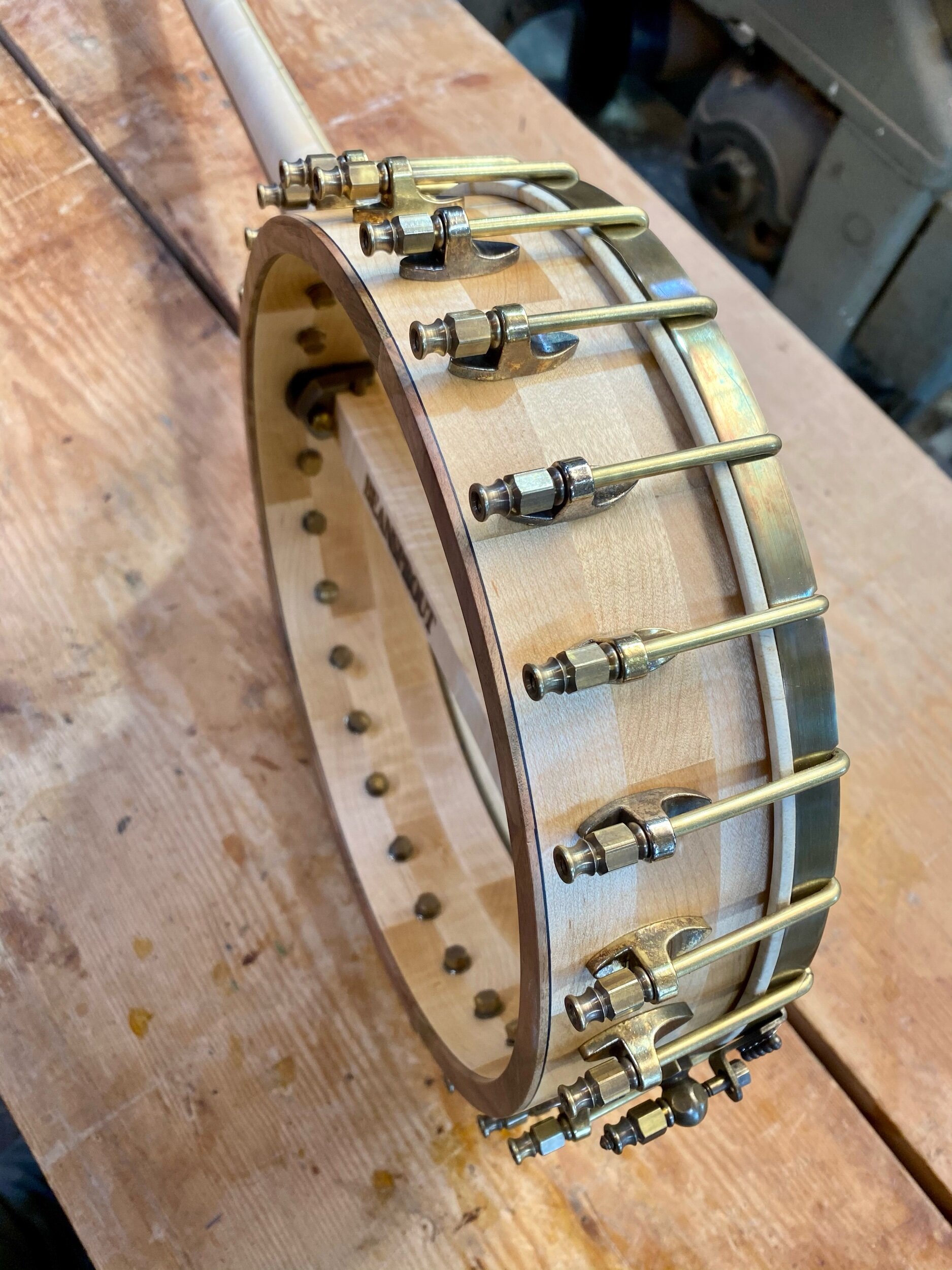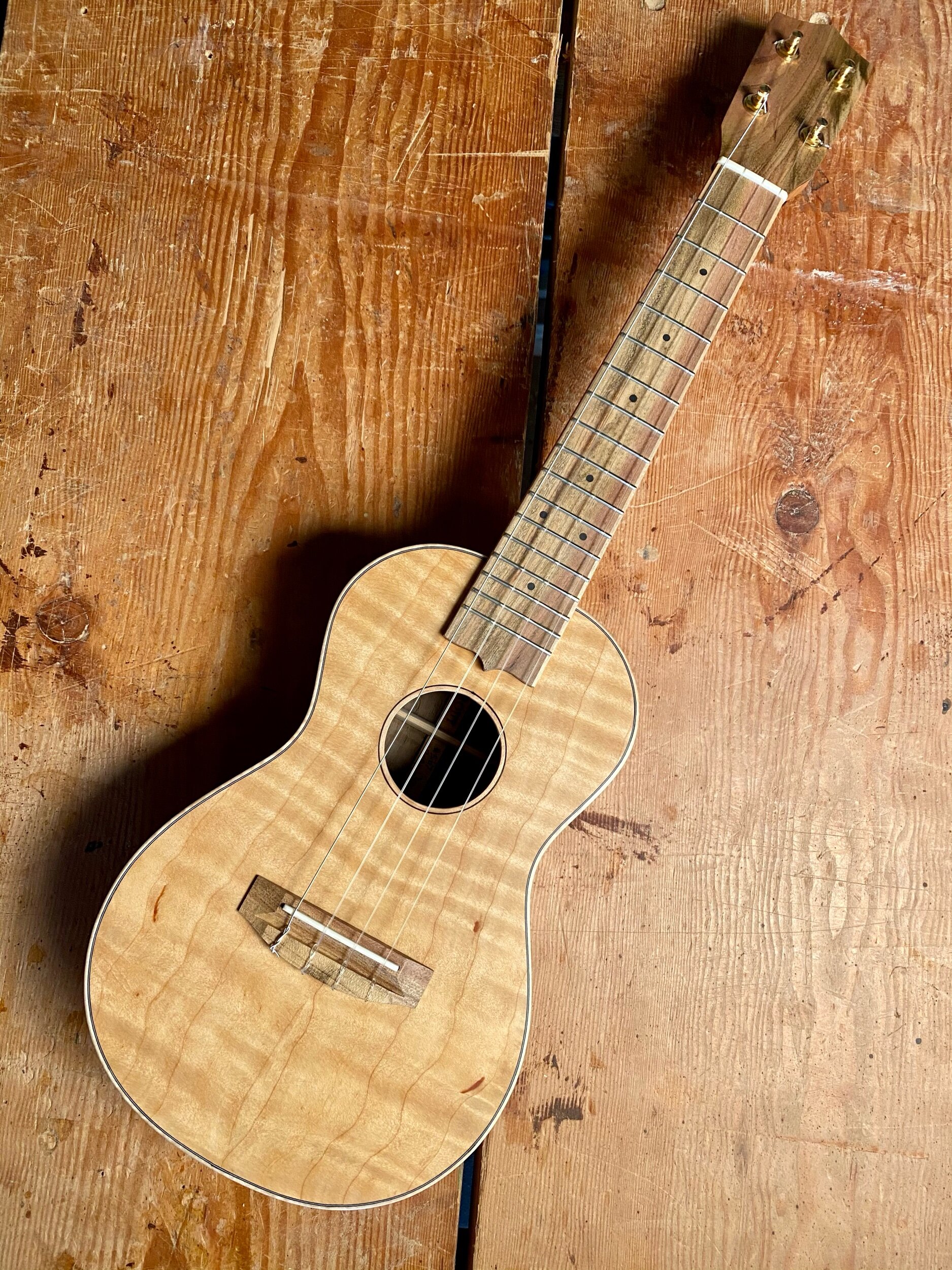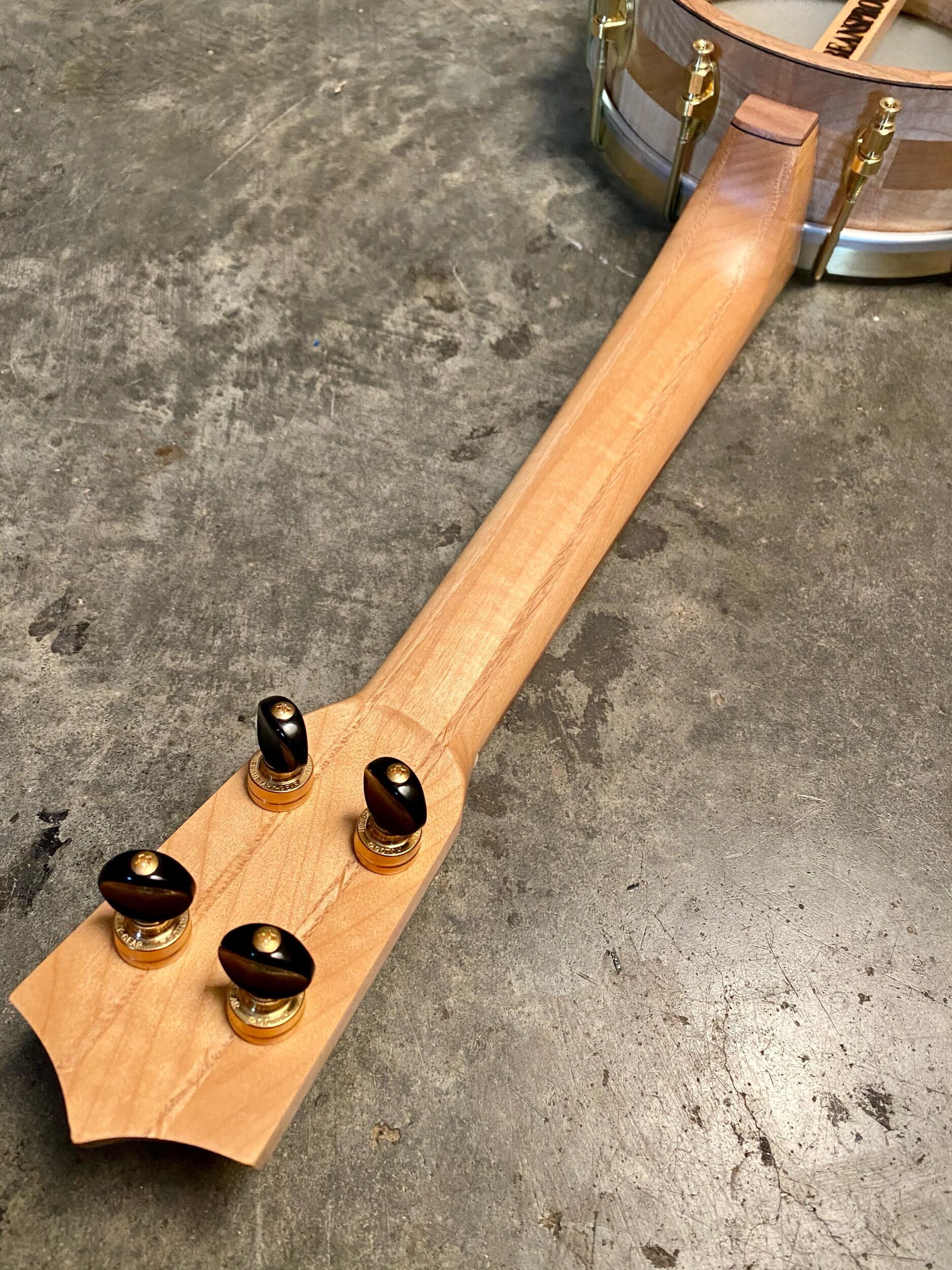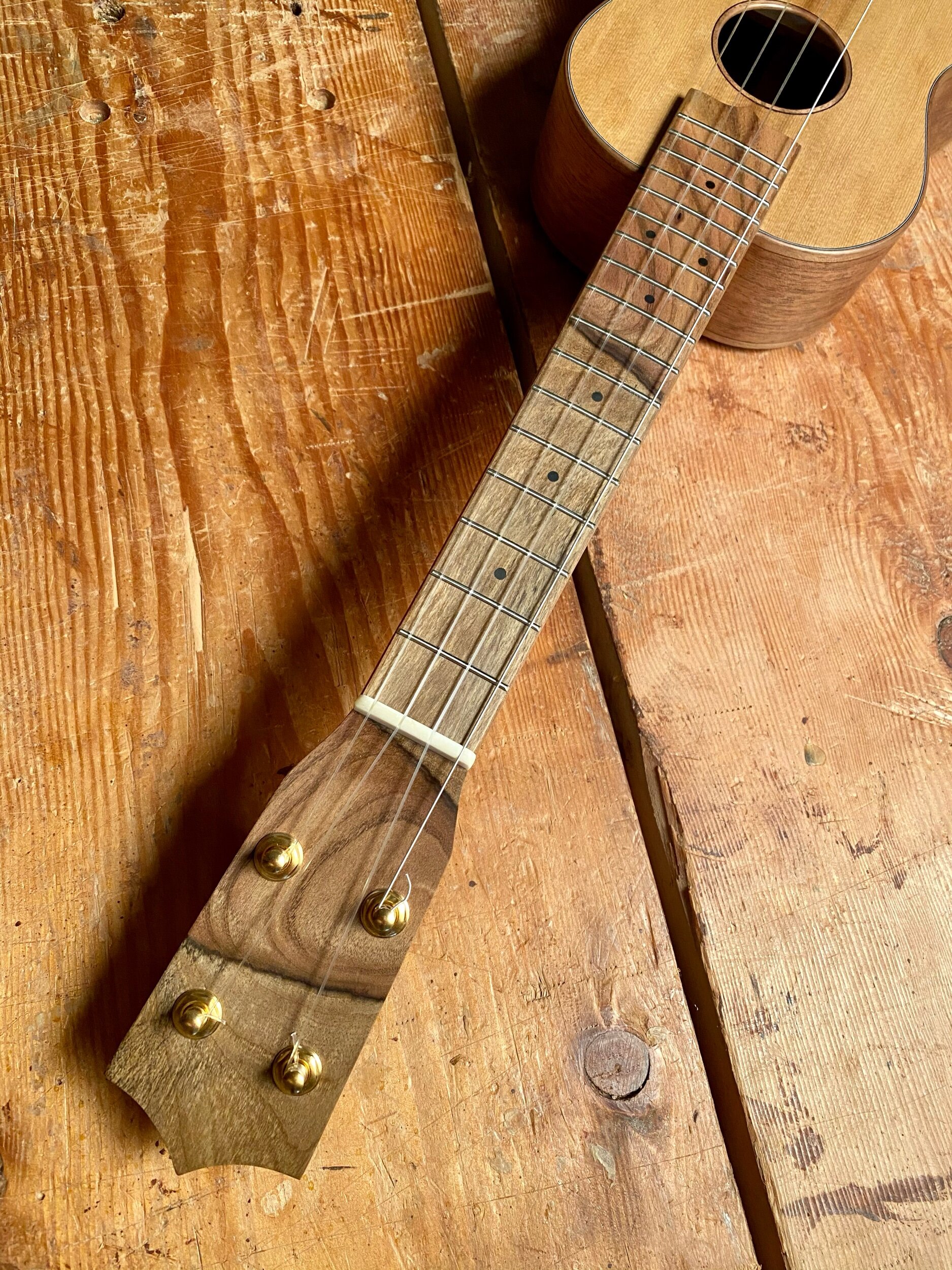Grafted wood really makes a big visual statement and this uke is no exception. The back and sides are some amazing grafted pistachio from California Orchards. The top is an asymmetrical piece of Port Orford Cedar with brown streaks in the grain. I used some mahogany that I got as scrap from a furniture maker for the neck and wrapped it all up with walnut binding. The customer asked for dgbe tuning with a high d, which is a favorite setup of mine.
#562- Maple and Cherry Short Scale Five String Banjo
This is the second banjo I have made of this design, pairing an 11” rim with a 20” scale neck. It’s lightweight, comfortable and easy to play. It took me a day or two to adjust my playing style to get the most tone from it, but now I love it. The rim is maple and pistachio and the neck is cherry, all stained to match with the color rubbed back to be almost translucent. The goatskin head is dyed with walnut husks from our yard and the brass has been darkened to form a nice patina. All the wood is from the Carpenter Ant stash in Portland.
“I haven’t put this down since I received it several days ago! It is a beautiful instrument with a beautiful sound. The sound is deep and plenty loud. I am able to tune it to G and lower because of the custom string set Aaron created. The fretboard is the most comfortable I have ever played. The short scale is great as I have had some surgeries on my hands, but I would love this even if I hadn’t. Thank you for such a carefully-made instrument.
- B. C. ”
#564- Curly Maple and Pistachio Five String Banjo
As far as the looks go, the pale maple, crazy pistachio and darkened brass is a cool combination. As far as sound, the curly maple, brass tone ring and goat skin head gives a vibrant and traditional vibe. I made my own brass tension hoop, tone ring and flesh hoop for this build and it was a nice challenge.
The curly maple came from Wildwood banjos when Mark retired and the pistachio is from California orchards.
“Hey Aaron-
Just a quick note to say that the banjo arrived safe and sound. It was here when I got home from work and I am just now putting it down. It is beautiful. I know I had a pretty specific vision for this instrument and you really knocked it out of the park. Thank you.
- C. E. ”
#565- Port Orford Cedar and Walnut Tenor Ukulele
Port orford cedar and walnut is a standard combo for us and it always delivers. This one is sweet and light, but also has a nice depth and sustain. The asymmetrical port orford cedar top is from the Oregon coast and the pistachio is from California orchards via woodfromthewest.com. The walnut back and sides are from Goby Walnut in Portland and the hemlock neck is from the Carpenter Ant Stash.
#567- Curly Port Orford Cedar and Curly Walnut Alto Ukulele
This lovely little alto ukulele is for a repeat customer from the UK. We had a tour planned for 2020 there, but obviously it didn’t happen. It seems a miracle that despite that, I can still make a thing to take the trip for me. As I played this a bunch today, the word “balanced” kept popping into my mind. It has a nice presence, but will not drown out a duet partner. It has a nice sustain and depth, but is not too dark. It’s lightweight but still solid. I’m very happy with it.
The curly Port Orford cedar is from the Oregon coast and the pistachio is from California orchards, both via woodfromthewest.com. The hemlock and walnut neck is made from scraps from last year’s backyard yurt project. The walnut back and sides is from the shorts bin at Goby Walnut in Portland.
#568- Cedar and Curly Cherry Tenor Ukulele
I’ve had a lot of trouble lately with small shop problems overwhelming my mind/soul. I intend to make rustic folk art, but my desire for improvement, Nicole’s careful quality control and our customer’s expectations push me to a higher level. This higher level brings with it insecurities and doubts that stop me from appreciating the wood, the time in the shop and the joy of playing these things. For this instrument, the customer gave me free reign to create with an emphasis on Wabi-Sabi. I embraced neutral wood tones, natural flaws and imperfections and the honest wear of a useful object. When I strung it up and played the first song, I cried a little as it filled me back up enough to keep going for the day.
The western red cedar top is from a burned out snag on the Washington side of the Columbia that my friend Ben knows about. The curly cherry is from the Carpenter Ant stash in Portland. The fir neck is from a floor joist that my friend Chris saved from a dumpster. The pistachio fretboard/headplate/bridge is from California orchards, harvested and milled by my friend Kevin. I like being alone in the shop all day, but writing this reminds me of how much I miss those folks and would love to have them all here for a visit.
Always forward, friends. You matter and so does whatever you did today.
“OMG - the sustain is incredible! ...and the intonation, and the action, and the feeling of my first radiused fretboard, and the finish, and the craftsmanship and attention to detail.
I can’t decide whether to look at it or to play it. Hard to do both. I can’t believe how loud and resonant it is, but also how much easier it is to play softly. The lightest touches still produce tone! It practically plays itself.
Aaron, I knew I would be pleased, but I am ECSTATIC! This is such an amazing instrument, and so easy to play.
Thank you ever so much!
- E. J.
”
#563- Curly Maple and Pistachio Concert Banjo Ukulele
As I make my banjo rims, I save any extra segments for later use. Sometimes I can match an orphan piece into another rim or I can match many orphans together to good effect. That is the case with this rim, made from curly maple segments from several other banjos. It still matches the curly maple neck, but offers a unique look. I also made my own brass tension hoop for this one, a process I hope I have more time for this year. The maple is from the Carpenter Ant stash in Portland and the pistachio is from California orchards.
“Dear Aaron and Nicole,
My banjolele arrived on Friday and I have been enjoying playing it ever since! I’m afraid my other ukes will have to stand in line for a bit, while I learn some new tunes and playing techniques.
Your work is so beautiful. I enjoyed the pictures along the way of the construction and then the personalized video, explaining the woods and process.
Stay well, keep making beautiful instruments and providing us with new learnings.
Many thanks from a very happy customer,
- J. C.
”
#561- Myrtle Scout Ukulele
Small but mighty, this Scout is sweet and fun to play. The Myrtle body is made from scraps from other ukuleles, the neck is cypress salvaged from an old mustard tank and the pistachio fretboard/headplate/bridge are from California Orchards.
“Hi Aaron, Nicole and Henry,
I spent the weekend playing my new Scout ukulele and I love it. It may have had a humble start in life as myrtle scraps, but the final instrument sounds great, feels good in your hands, and is beautiful to look at.
I couldn’t be happier with it!
To me, the sound is classic ukulele with some banjo thrown into the mix. It has volume and sustain, without being too bright, and it is very responsive. When picking, individual notes ring out true and clear, and intonation is spot on all the way up the neck. This makes it a great little uke for many different styles of music.
It is also beautiful to look at and admire as a piece of folk art and fine craftsmanship. Pictures don’t do it justice. The “scrap” myrtle is full of character and is paired very well with the pistachio headplate, fingerboard, and bridge. The “mustard tank” reclaimed cedar neck has a wonderful texture and grain. This ukulele just feels good in your hands and begs to be played.
Your instruments and music bring happiness to people’s lives. Even more than that, how you approach these endeavors and your customers - with sincerity and intention - comes through in what you do. I hope that maybe, when you’re having a bad day (or week!), you can stop to catch your breath and take some comfort in knowing that, somewhere, at that very moment ... someone might be playing one of your instruments or listening to your music, and they are having a better day because of you.
Thanks again!
- F. Q. ”
#560- Curly Port Orford Cedar and Curly Walnut Tenor Ukulele
Port Orford Cedar and Walnut have become a standard for us. They are local woods that look and sound great and I am proud to use them. I chose salvaged Douglas fir for the neck and pistachio for the fretboard, headplate and bridge. When sanded and polished with the thin, hand rubbed finish that I use, a myriad of textures appear, flying in the face of the sterile modern aesthetic that most products shoot for. All the wood except the fir is from woodfromthewest.com, the fir is from salvaged floor joists from a Portland dumpster. It is lightweight, vibrant and one of a kind, ready for music time!
#557- Fir and Curly Cherry Tenor Ukulele
Douglas fir is one of my favorite top woods. It’s plenty loud, but has a richness to it and a dry snap that I like. It would pair well with any hardwood back and sides, but this curly cherry is particularly nice. How about a curly cherry neck too? The fir and cherry are from the Carpenter Ant stash in Portland, the pistachio is from California Orchards.
#559- Cedar and Walnut Alto Ukulele
Wow- this is a sweet one with a simple but unique look. The top is old growth western red cedar cut from a water tank from Vashon Island. It is has little swirling figures in it that I can’t account for, but I love. The Oregon walnut back and sides is an asymmetrical set, culled from the scrap bin at Goby in Portland. The grafted pistachio fretboard, headplate and bridge is from California orchards. Salvaged fir and walnut neck from and old floor joist from Portland.
“Hi Aaron, Nicole and Henry!
I feel incredibly fortunate to be the lucky recipient of this amazing ukulele. She is an Heirloom Ukulele and I’m already thinking that I need to change my Will in order to bequeath her to someone special!
I can’t thank you enough. Maisie (Yep, I’ve already named her) looks and sounds incredible. The tone and sustain are fantastic. This is the first uke that I have owned where I have felt the music reverberate through my body when I play. Now, if that isn’t sound therapy,
I don’t know what is! She sounds AMAZING!
And...you built me exactly what was in my head, Aaron. She is 100% what I was hoping for and 200% more than I could ever have expected.
Thank you again for everything. I am going to enjoy Maisie till the cows come home!
All the best,
R. H.
”
#556- Curly Walnut and Pistachio Five String Banjo
This instrument is for a student of Steve Varney, so this banjo is pretty close to his instrument. 12” walnut block rim with a brass tone ring, fiberskyn head and steel strings. The curly walnut for the neck and rim and the pistachio fretboard and head plate are from California orchards via woodfromthewest.com. This instrument feels dark and rich, but the brass ring helps it sing too. It’s very comfortable to play and I’ll be sad/happy to see it go!
“Is this what a real banjo sounds and feels like?????? Wow – it’s a whole new world.
Aaron – this is truly fantastic. Everything is what I had hoped it would be – tone, wood, general feel, neck shaping, weight. Everything. Marvelous job and Thank You!
- H. J. ”
#551- Bearclaw Spruce and Curly Walnut Scout Ukulele
Sweet, simple and made from shop scraps. A soprano uke with a small round body based on the old Lyon and Healy camp uke. The cherry and mahogany are from the Carpenter Ant stash, the spruce is old growth salvage from Alaska and the curly walnut is from woodfromthewest.com.
“Aaron and company,
#551 has arrived safe and sound.
First impressions, stout but light, a finish that doesn’t disrespect the natural beauty of years of growth, and the claw stands out even better in person. Sounds full, yet humble.
This instrument is bottom line, not a novelty item. The potential portability, without compromises in quality, leads me to believe that I will be traveling miles up and down the fretboard, and wherever else the music leads me.
Again, thanks for your kindness and craftsmanship.
A true gift.
Peace
- J. D. ”
#555- Figured Oak Tenor Banjo Ukulele
I really like white oak for banjos lately. It’s loud and crisp with a dusty edge to it, like it’s already old. This oak is from the Carpenter Ant stash in Portland and was likely cut for furniture or clock cases originally. It also uses an oak bridge made from a wine barrel from the winery up the road. The pistachio fretboard and headplate is from California orchards.
#558- Curly Myrtle Baritone Ukulele
For many years, my personal instrument was a Myrtle baritone and the sound and feel is quite comfortable to me. I appreciate that this instrument has such a simple design, really showing off the wood grain as the star of the show. The curly Myrtle is from the Carpenter ant stash, the pistachio fretboard, headplate and bridge are from California orchards and the mahogany neck is salvaged from a construction beam.
“The new addition arrived a day earlier than predicted! So light and wonderful to play!! My own little Beansprout heaven. Thank you for your skill, craftsmanship; I can feel the love in these two and I know we will be together forever.
- M. R. ”
#554- Walnut and Pistachio Four String Banjo
Normally this model has an 11” rim, but we chose a 12” rim to try to get a deeper sound. The rich walnut block rim is balanced with a rolled brass tone ring, making a complex but lively sound. The goat skin head also adds to the funkiness of the sound, in my opinion. It is strung with baritone ukulele strings and tuned DGBE. The customer added a scoop at the end of the fretboard for easy strumming and a K&K pickup for easy amplification. The Oregon walnut is urban salvage from the Willamette Valley and the pistachio is from California orchards.
#552- Western Red Cedar and Mahogany Tenor Ukulele
This instrument is for our friend Lori, who has a cedar and mahogany guitar that she really likes the sound of. I grabbed a figured cedar top that was salvaged from a on old water tank, some mahogany I reclaimed from the rebuild it center and some bird’s eye maple from the Carpenter Ant stash. I wanted to keep it simple, so I bound just the top with some maple to protect the cedar and left it alone. This cedar has an AMAZING sound and it just keeps going, no matter how hard I play.
#550- Spruce and Curly Maple Baritone Ukulele
For many of us, our hands touch almost exclusively machine made items. Modern design generally celebrates the sleek and smooth, with little variation of texture. But handmade items allow the owner to experience many textures, which I think add to their beauty. Our bodies and eyes may sense these small variations, triggering a connection to the handmade item that is different than your smooth iPhone or the plastic fork from the takeout place. This uke only uses a handful of woods, but it does offer the textural experience, for both the the hand and eye, that I love.
The top is Sitka spruce from my dulcimer maker’s stash. The curly maple back and sides were given to me by a retiring violin maker. The maple fretboard, headplate and bridge are from some maple salvaged by Ken from the Carpenter Ant stash from a piece of oat processing equipment. It is over 100 years old, very hard and is the wood I chose to make my workbench from. The neck is made from some hemlock and oak from the Carpenter Ant stash as well.
This uke sounds vibrant and rich, with a depth of sound that I really love. In my opinion, it already looks and sounds old, a fitting instrument to close out 2020!
“What a lovely instrument! It has all sorts of volume, individual notes ring forever (I almost want to say they “chime”) and it has a lot of bass for a baritone (as we might’ve said in choir). About your sense that it seems “old” already, I chose this combination of woods, after watching your wood selection video several times, in which you recommend maple & spruce. Since that’s also what Stradivarius used, I thought, “Well, you can’t beat the old masters”. It’s sweet-sounding, gorgeous to look at, and a classic already. You did well and seem to have a sixth sense about what your customers want. Thank you.
- C. E. ”
#547- Walnut and Pistachio Five String Banjo
The last few days that a banjo is on my bench are fussy ones. Lots of small details to dial in and little touch ups to make as I try to remain focused and sane. But then, something magical happens: it’s ready to make music and I get to play it! Not only is this a fun part of the job, but it also adds another layer to the data in my head about how the instruments sound and feel. This one has been great and I’m happy/sad to see it go. Made from some beautiful black walnut from Port Townsend, WA and pistachio from California orchards. Brass hooks and nuts from Brooks Masten.
#549- Port Orford Cedar and Curly Walnut Baritone Ukulele
This one is bread and butter for me: simple domestic woods, easy playability, rich resonant tone and light weight construction. I’ve had a great time playing it around the holidays and I’ll be sad to see it go! Port Orford Cedar from the Oregon coast, curly walnut from Goby Walnut in Portland, pistachio from California orchards and mahogany salvaged from a local renovation project.
“The Baritone arrived safely two days ago here in Switzerland. First impression: lighter than expected! Feels very good, looks beautiful and the sound volume is impressive for such a small instrument. I’m really glad that I went for this size and I’m sure it will make me - and hopefully some others - happy for a long time. Thanks so much for this beautiful work!
- R. B. ”



